Panasonic TX-P42UT30B-Y Schematic

ORDER NO.PCZ1106109CE
Plasma Television
Model No. TX-P42UT30B
TX-P42UT30Y
GPF14D-E Chassis
© Panasonic Corporation 2011.
Unauthorized copying and distribution is a violation of law.
TABLE OF CONTENTS
PAGE |
|
PAGE |
|
1 Safety Precautions ----------------------------------------------- |
3 |
11.1. Caution statement. |
-------------------------------------- 41 |
1.1. General Guidelines ---------------------------------------- |
3 |
11.2. Wiring (1) -------------------------------------------------- |
41 |
1.2. Touch-Current Check-------------------------------------- |
3 |
11.3. Wiring (2) -------------------------------------------------- |
42 |
2 Warning -------------------------------------------------------------- |
4 |
11.4. Wiring (3) -------------------------------------------------- |
42 |
2.1. Prevention of Electrostatic Discharge (ESD) |
|
11.5. Wiring (4) -------------------------------------------------- |
43 |
to Electrostatically Sensitive (ES) Devices ---------- |
4 |
11.6. Wiring (5) -------------------------------------------------- |
43 |
2.2. About lead free solder (PbF) ---------------------------- |
5 |
12 Schematic Diagram |
|
3 Service Navigation------------------------------------------------ |
6 |
13 Printed Circuit Board |
|
3.1. PCB Layout-------------------------------------------------- |
6 |
14 Exploded View |
|
3.2. Applicable signals------------------------------------------ |
7 |
|
|
4 Specifications ------------------------------------------------------ |
8 |
|
|
5 Technical Descriptions---------------------------------------- |
10 |
|
|
5.1. Specification of KEY for CI Plus, DTCP-IP, |
|
|
|
WIDEVINE and One-to-One -------------------------- |
10 |
|
|
6 Service Mode ----------------------------------------------------- |
11 |
|
|
6.1. How to enter into Service Mode ---------------------- |
11 |
|
|
6.2. Option - Mirror--------------------------------------------- |
13 |
|
|
6.3. Service tool mode---------------------------------------- |
13 |
|
|
6.4. Hotel mode------------------------------------------------- |
14 |
|
|
6.5. Data Copy by SD Card --------------------------------- |
15 |
|
|
7 Troubleshooting Guide---------------------------------------- |
18 |
|
|
7.1. Check of the IIC bus lines------------------------------ |
18 |
|
|
7.2. Power LED Blinking timing chart --------------------- |
19 |
|
|
7.3. No Power--------------------------------------------------- |
19 |
|
|
7.4. No Picture-------------------------------------------------- |
20 |
|
|
7.5. Local screen failure-------------------------------------- |
21 |
|
|
8 Disassembly and Assembly Instructions--------------- |
22 |
|
|
8.1. Remove the Rear cover -------------------------------- |
22 |
|
|
8.2. Remove the AC inlet ------------------------------------ |
22 |
|
|
8.3. Remove the P-Board------------------------------------ |
22 |
|
|
8.4. Remove the Side terminal cover --------------------- |
22 |
|
|
8.5. Remove the Tuner unit --------------------------------- |
22 |
|
|
8.6. Remove the A-Board------------------------------------ |
23 |
|
|
8.7. Remove the Speakers ---------------------------------- |
23 |
|
|
8.8. Remove the SN-Board---------------------------------- |
23 |
|
|
8.9. Remove the SS-Board---------------------------------- |
23 |
|
|
8.10. Remove the Stand bracket and the Hanger |
|
|
|
metals ------------------------------------------------------- |
24 |
|
|
8.11. Remove the Plasma panel section from the |
|
|
|
Cabinet assy----------------------------------------------- |
24 |
|
|
8.12. Remove the Radiator plate ---------------------------- |
24 |
|
|
8.13. Remove the C1-Board ---------------------------------- |
25 |
|
|
8.14. Remove the C2-Board ---------------------------------- |
25 |
|
|
8.15. Remove the Attachment metal bottom-------------- |
25 |
|
|
8.16. Remove the Attachment metal top------------------- |
25 |
|
|
8.17. Remove the Glass holders ---------------------------- |
25 |
|
|
8.18. Remove the K-Board------------------------------------ |
26 |
|
|
8.19. Remove the V-Board ------------------------------------ |
26 |
|
|
8.20. Replace the Plasma panel----------------------------- |
26 |
|
|
9 Measurements and Adjustments -------------------------- |
27 |
|
|
9.1. Adjustment------------------------------------------------- |
27 |
|
|
10 Block Diagram --------------------------------------------------- |
35 |
|
|
10.1. Main Block Diagram ------------------------------------- |
35 |
|
|
10.2. Block (1/4) Diagram ------------------------------------- |
36 |
|
|
10.3. Block (2/4) Diagram ------------------------------------- |
37 |
|
|
10.4. Block (3/4) Diagram ------------------------------------- |
38 |
|
|
10.5. Block (4/4) Diagram ------------------------------------- |
39 |
|
|
11 Wiring Connection Diagram --------------------------------- |
41 |
|
|
2
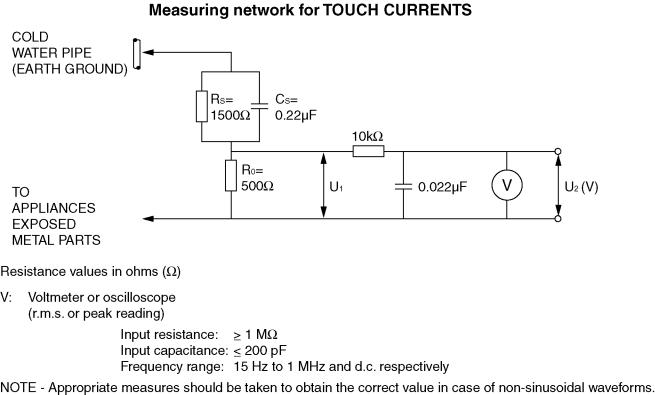
1 Safety Precautions
1.1.General Guidelines
1.When conducting repairs and servicing, do not attempt to modify the equipment, its parts or its materials.
2.When wiring units (with cables, flexible cables or lead wires) are supplied as repair parts and only one wire or some of the wires have been broken or disconnected, do not attempt to repair or re-wire the units. Replace the entire wiring unit instead.
3.When conducting repairs and servicing, do not twist the Fasten connectors but plug them straight in or unplug them straight out.
4.When servicing, observe the original lead dress. If a short circuit is found, replace all parts which have been overheated or damaged by the short circuit.
5.After servicing, see to it that all the protective devices such as insulation barriers, insulation papers shields are properly installed.
6.After servicing, make the following leakage current checks to prevent the customer from being exposed to shock hazards.
1.2.Touch-Current Check
1.Plug the AC cord directly into the AC outlet. Do not use an isolation transformer for this check.
2.Connect a measuring network for touch currents between each exposed metallic part on the set and a good earth ground such as a water pipe, as shown in Figure 1.
3.Use Leakage Current Tester (Simpson 228 or equivalent) to measure the potential across the measuring network.
4.Check each exposed metallic part, and measure the voltage at each point.
5.Reserve the AC plug in the AC outlet and repeat each of the above measure.
6.The potential at any point (TOUCH CURRENT) expressed as voltage U1 and U2, does not exceed the following values: For a. c.: U1 = 35 V (peak) and U2 = 0.35 V (peak);
For d. c.: U1 = 1.0 V,
Note:
The limit value of U2 = 0.35 V (peak) for a. c. and U1 = 1.0 V for d. c. correspond to the values 0.7 mA (peak) a. c. and 2.0 mA d. c.
The limit value U1 = 35 V (peak) for a. c. correspond to the value 70 mA (peak) a. c. for frequencies greater than 100 kHz.
7.In case a measurement is out of the limits specified, there is a possibility of a shock hazard, and the equipment should be repaired and rechecked before it is returned to the customer.
Figure 1
3
2 Warning
2.1.Prevention of Electrostatic Discharge (ESD) to Electrostatically
Sensitive (ES) Devices
Some semiconductor (solid state) devices can be damaged easily by static electricity. Such components commonly are called Electrostatically Sensitive (ES) Devices. Examples of typical ES devices are integrated circuits and some field-effect transistors and semiconductor [chip] components. The following techniques should be used to help reduce the incidence of component damage caused by electrostatic discharge (ESD).
1.Immediately before handling any semiconductor component or semiconductor-equipped assembly, drain off any ESD on your body by touching a known earth ground. Alternatively, obtain and wear a commercially available discharging ESD wrist strap, which should be removed for potential shock reasons prior to applying power to the unit under test.
2.After removing an electrical assembly equipped with ES devices, place the assembly on a conductive surface such as aluminum foil, to prevent electrostatic charge buildup or exposure of the assembly.
3.Use only a grounded-tip soldering iron to solder or unsolder ES devices.
4.Use only an anti-static solder removal device. Some solder removal devices not classified as [anti-static (ESD protected)] can generate electrical charge sufficient to damage ES devices.
5.Do not use freon-propelled chemicals. These can generate electrical charges sufficient to damage ES devices.
6.Do not remove a replacement ES device from its protective package until immediately before you are ready to install it. (Most replacement ES devices are packaged with leads electrically shorted together by conductive foam, aluminum foil or comparable conductive material).
7.Immediately before removing the protective material from the leads of a replacement ES device, touch the protective material to the chassis or circuit assembly into which the device will be installed.
Caution
Be sure no power is applied to the chassis or circuit, and observe all other safety precautions.
8.Minimize bodily motions when handling unpackaged replacement ES devices. (Otherwise ham less motion such as the brushing together of your clothes fabric or the lifting of your foot from a carpeted floor can generate static electricity (ESD) sufficient to damage an ES device).
4

2.2.About lead free solder (PbF)
Note: Lead is listed as (Pb) in the periodic table of elements.
In the information below, Pb will refer to Lead solder, and PbF will refer to Lead Free Solder. The Lead Free Solder used in our manufacturing process and discussed below is (Sn+Ag+Cu). That is Tin (Sn), Silver (Ag) and Copper (Cu) although other types are available.
This model uses Pb Free solder in it's manufacture due to environmental conservation issues. For service and repair work, we'd suggest the use of Pb free solder as well, although Pb solder may be used.
PCBs manufactured using lead free solder will have the PbF within a leaf Symbol PbF stamped on the back of PCB.
Caution
•Pb free solder has a higher melting point than standard solder. Typically the melting point is 50 ~ 70 °F (30~40 °C) higher. Please use a high temperature soldering iron and set it to 700 ± 20 °F (370 ± 10 °C).
•Pb free solder will tend to splash when heated too high (about 1100 °F or 600 °C).
If you must use Pb solder, please completely remove all of the Pb free solder on the pins or solder area before applying Pb solder. If this is not practical, be sure to heat the Pb free solder until it melts, before applying Pb solder.
•After applying PbF solder to double layered boards, please check the component side for excess solder which may flow onto the opposite side. (see figure below)
Suggested Pb free solder
There are several kinds of Pb free solder available for purchase. This product uses Sn+Ag+Cu (tin, silver, copper) solder. However, Sn+Cu (tin, copper), Sn+Zn+Bi (tin, zinc, bismuth) solder can also be used.
5
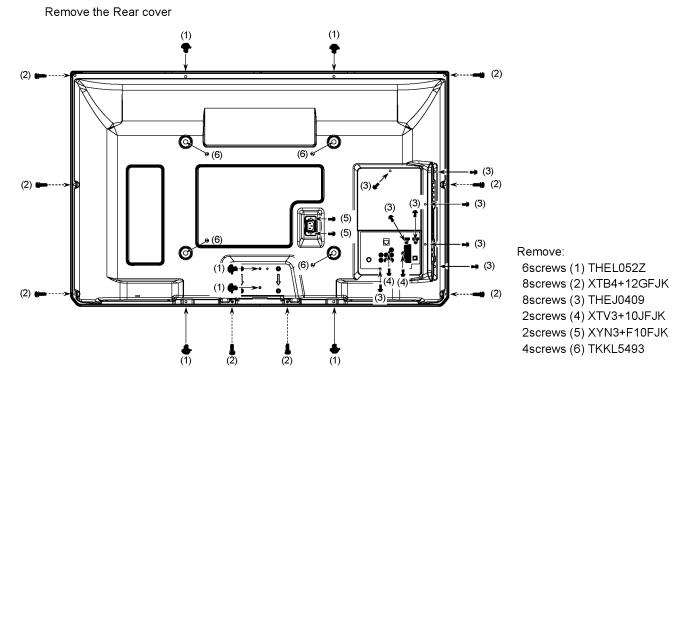
3 Service Navigation
3.1.PCB Layout
Board Name |
Function |
Board Name |
Function |
P |
Power Supply |
C1 |
Data Driver (Lower Right) |
|
Non serviceable |
|
|
|
C2 |
Data Driver (Lower Left) |
|
|
P-Board should be exchange for service |
|
|
|
SN |
Scan Drive |
|
A |
Main AV input, processing |
SS |
Sustain Drive |
K |
Remote receiver, Power LED, C.A.T.S. sensor |
|
|
V |
3D Eyewear transmitter |
|
|
6
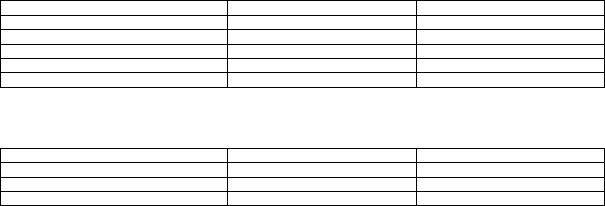
3.2.Applicable signals
COMPONENT (Y, PB, PR), HDMI
* Mark: Applicable input signal
|
|
|
Signal name |
COMPONENT |
HDMI |
525 |
(480) |
/ 60i, 60p |
* |
* |
|
625 |
(576) |
/ 50i, 50p |
* |
* |
|
750 |
(720) |
/ 60p, 50p |
* |
* |
|
1,125 (1,080) |
/ 60i, 50i |
* |
* |
||
1,125 (1,080) |
/ 60p, 50p, 24p |
|
* |
||
PC (from HDMI terminal)
Applicable input signal for PC is basically compatible to HDMI standard timing.
|
Signal name |
Horizontal frequency (kHz) |
Vertical frequency (Hz) |
640 × 480 @60 Hz |
31.47 |
60.00 |
|
1,280 |
× 720 @60 Hz |
45.00 |
60.00 |
1,920 |
× 1,080 @60 Hz |
67.50 |
60.00 |
Note
•Signals other than above may not be displayed properly.
•The above signals are reformatted for optimal viewing on your display.
•PC signal is magnified or compressed for display, so that it may not be possible to show fine detail with sufficient clarity.
7
4 Specifications
Power Source
Rated Power Consumption On mode Average Power Consumption (Y)
Standby Power Consumption
Display panel
Aspect Ratio
Visible screen size
Number of pixels
Sound
Speaker Audio Output Headphones
Receiving Systems / Band name (UK)
Receiving Systems / Band name (Ireland)
Receiving Systems / Band name (Y)
Aerial input
Operating Conditions
Connection Terminals
AV1 (SCART)
AV2 input
COMPONENT input
HDMI1 / 2 / 3 input
Card slot
ETHERNET
USB 1 / 2
AUDIO IN
AC 220-240 V, 50 / 60 Hz 270 W
121 W
(based on IEC 62087 Ed.2 measurement method) 0.40 W
16.00 W (With monitor out recording)
16:9
106 cm (diagonal)
921 mm (W) × 518 mm (H)
2,073,600 (1,920 (W) × 1,080 (H)) [5,760 × 1,080 dots]
(160 mm × 40 mm) × 2, 6 Ω
20 W (10 W + 10 W)
M3 (3.5 mm) stereo mini Jack × 1
DVB-T / T2 |
Digital terrestrial services. |
PAL I |
UHF E21-68 |
PAL 525/60 |
Playback of NTSC tape from some PAL Video recorders (VCR) |
|
or NTSC disc playback from DVD player and recorder. |
M.NTSC |
Playback from M.NTSC Video recorders (VCR). |
NTSC (AV input only) |
Playback from NTSC Video recorders (VCR). |
DVB-T |
Digital terrestrial services. |
PAL I |
VHF A -J |
|
UHF E21-69 |
|
CATV S1 - S20 |
|
CATV S21 - S41 (Hyperband) |
PAL 525/60 |
Playback of NTSC tape from some PAL Video recorders (VCR) |
|
or NTSC disc playback from DVD player and recorder. |
M.NTSC |
Playback from M.NTSC Video recorders (VCR). |
NTSC (AV input only) |
Playback from NTSC Video recorders (VCR). |
PAL B, G, H, I, SECAM B, G, SECAM L, L' |
|
VHF E2 - E12 |
VHF H1 - H2 (ITALY) |
VHF A - H (ITALY) |
UHF E21 - E69 |
CATV (S01 - S05) |
CATV S1 - S10 (M1 - M10) |
CATV S11 - S20 (U1 - U10) |
CATV S21 - S41 (Hyperband) |
PAL D, K, SECAM D, K |
|
VHF R1 - R2 |
VHF R3 - R5 |
VHF R6 - R12 |
UHF E21 - E69 |
PAL 525/60 |
Playback of NTSC tape from some PAL Video recorders (VCR) |
M.NTSC |
Playback from M. NTSC Video recorders (VCR) |
NTSC (AV input only) |
Playback from NTSC Video recorders (VCR) |
DVB-T/T2 |
Digital terrestrial services (MPEG2 and MPEG4-AVC(H.264)) |
DVB-C |
Digital cable services (MPEG2 and MPEG4-AVC(H.264)) |
•Check the latest information on the available services at the following website. (English only) http://panasonic.jp/support/global/cs/tv/
UHF (UK) |
VHF / UHF (Ireland/Y) |
Temperature: |
0 °C- 35 °C |
Humidity: |
20 % - 80 % RH (non-condensing) |
21 Pin terminal (Audio/Video in, Audio/Video out, RGB in, Q-Link) |
|
VIDEO: |
RCA PIN Type × 1 1.0 V [p-p] (75 Ω) |
AUDIO L-R: |
RCA PIN Type × 2 0.5 V [rms] |
Y: |
1.0 V [p-p] (including synchronization) |
PB, PR: |
±0.35 V [p-p] |
TYPE A Connectors |
|
HDMI1 / 3 : |
3D, Content Type, Deep Colour, x.v.Colour™ |
HDMI2 : |
3D, Content Type, Audio Return Channel, Deep Colour, |
|
x.v.Colour™ |
• This TV supports " HDAVI Control 5 " function. SD CARD slot × 1
Common Interface slot (complies with CI Plus (Y)) × 1 RJ45, IEEE802.3 10BASE-T / 100BASE-TX
USB2.0 DC 5 V, Max. 500 mA |
|
RCA PIN Type × 2 |
0.5 V [rms] |
8
AUDIO OUT |
RCA PIN Type × 2 |
0.5 V [rms] (high impedance) |
DIGITAL AUDIO OUT |
PCM / Dolby Digital / DTS, Fiber optic |
|
Dimensions (W × H × D) |
1,023 mm × 671 mm × 320 mm (With Pedestal) |
|
|
1,023 mm × 637 mm × 93 mm (TV only) |
|
Mass |
27.5 kg Net (With Pedestal) |
|
|
24.0 kg Net (TV only) |
|
Note
•Design and Specifications are subject to change without notice. Mass and Dimensions shown are approximate.
•This equipment complies with the EMC standards listed below. EN55013, EN61000-3-2, EN61000-3-3, EN55020, EN55022, EN55024
9
5 Technical Descriptions
5.1.Specification of KEY for CI Plus, DTCP-IP, WIDEVINE and One-to-One
5.1.1. |
General information: |
|
1. |
EEPROM (IC8902) for spare parts has the seed of KEY for each. |
|
2. |
The final KEY data will be generated by Peaks IC (IC8000) when SELF CHECK was done and are stored in both Peaks IC |
|
|
(IC8000) and EEPROM (IC8902). |
|
|
Three KEY are not generated for all models. |
|
|
The necessary KEY are only generated and stored depend on the feature of models. |
|
5.1.2. |
Replacement of ICs: |
|
When Peaks IC (IC8000) is replaced, EEPROM (IC8902) should be also replaced with new one the same time. When EEPROM (IC8902) is replaced, Peaks IC (IC8000) is not necessary to be replaced the same time.
After the replacement of IC, SELF CHECK should be done to generate the final KEY data.
How to SELF CHECK: While pressing [VOLUME ( - )] button on the main unit, press [MENU] button on the remote control for more than 3 seconds.
TV will be forced to the factory shipment setting after this SELF CHECK.
5.1.3.Model and Keys:
Model No. |
|
|
Keys |
|
|
|
One-to-One |
CI Plus |
|
DTCP-IP |
WIDEVINE |
|
(For USB Rec.) |
|
|
|
|
TX-P42UT30B |
None |
None |
|
None |
Yes |
TX-P42UT30Y |
None |
Yes |
|
None |
Yes |
10

6 Service Mode
6.1.How to enter into Service Mode
6.1.1.Purpose
After exchange parts, check and adjust the contents of adjustment mode.
While pressing [VOLUME ( - )] button of the main unit, press [0] button of the remote control three times within 2 seconds.
Note:
Service Mode can not be entered when 3D signal input. Input 2D signal to enter Service Mode.
6.1.2.Key command
[1]button...Main items Selection in forward direction
[2]button...Main items Selection in reverse direction
[3]button...Sub items Selection in forward direction
[4]button...Sub items Selection in reverse direction [RED] button...All Sub items Selection in reverse direction
[GREEN] button...All Sub items Selection in forward direction
[VOL] button...Value of sub items change in forward direction ( + ), in reverse direction ( - )
6.1.3.How to exit
Switch off the power with the [POWER] button on the main unit or the [POWER] button on the remote control.
11
6.1.4.Contents of adjustment mode
•Value is shown as a hexadecimal number.
•Preset value differs depending on models.
•After entering the adjustment mode, take note of the value in each item before starting adjustment.
Main item |
|
Sub item |
|
|
Sample Data |
Remark |
||
ADJUST |
CONTRAST |
|
277 |
|
|
|
||
|
COLOR |
|
36 |
|
|
|
||
|
TINT |
|
00 |
|
|
|
||
|
SUB-BRT |
|
800 |
|
|
|
||
|
H-POS |
|
0 |
|
|
|
||
|
H-AMP |
|
0 |
|
|
|
||
|
V-POS |
|
0 |
|
|
|
||
|
V-AMP |
|
0 |
|
|
|
||
WB-ADJ |
R-CUT |
|
80 |
|
|
|
||
|
G-CUT |
|
80 |
|
|
|
||
|
B-CUT |
|
80 |
|
|
|
||
|
R-DRV |
|
EE |
|
||||
|
G-DRV |
|
FF |
|
||||
|
B-DRV |
|
86 |
|
|
|
||
|
ALL-CUT |
|
80 |
|
|
|
||
|
ALL-DRV |
|
FF |
|
||||
OPTION |
Panel-Type |
|
42FHD |
Factory Preset |
||||
|
Boot |
|
ROM |
|
||||
|
STBY-SET |
|
00 |
|
|
|
||
|
EMERGENCY |
|
ON |
|
||||
|
Y/C Delay |
|
|
|
|
|
||
|
OPT 1 |
|
00010100 |
|
|
|||
|
OPT 2 |
|
11101110 |
|
|
|||
|
OPT 3 |
|
00000001 |
|
|
|||
|
OPT 4 |
|
00010000 |
|
|
|||
|
EDID-CLK |
|
MID |
|
||||
|
MIRROR |
|
00 (See Option-Mirror) |
|
||||
|
AMR-SELECT |
|
OFF |
|
||||
VSUS |
|
|
|
|
LOW |
See Vsus selection |
||
AGING |
ALL WHITE |
|
|
|
|
Built-in test patterns can be |
||
|
|
|
|
|
|
|
displayed. |
|
|
ALL BLUE WITH WHITE OUTSIDE FRAME |
|
|
|
||||
|
ALL GREEN |
|
|
|
|
|
||
|
ALL RED |
|
|
|
|
|
||
|
LOW STEP WHITE |
|
|
|
|
|
||
|
LOW STEP BLUE |
|
|
|
|
|
||
|
LOW STEP GREEN |
|
|
|
|
|
||
|
LOW STEP RED |
|
|
|
|
|
||
|
WHITE DIAGONAL STRIPE |
|
|
|
|
|
||
|
RED DIAGONAL STRIPE |
|
|
|
|
|
||
|
GREEN DIAGONAL STRIPE |
|
|
|
|
|
||
|
BLUE DIAGONAL STRIPE |
|
|
|
|
|
||
|
A-ZONE & B-ZONE |
|
|
|
|
|
||
|
1% WINDOW |
|
|
|
|
|
||
|
COLOR BAR |
|
|
|
|
|
||
|
9 POINTS BRIGHT MEASURE |
|
|
|
|
|
||
|
2 DOT OUTSIDE FRAME |
|
|
|
|
|
||
|
ALL BLUE |
|
|
|
|
|
||
|
DOUBLE FIXED 1% WINDOW |
|
|
|
|
|
||
|
VERTICAL LINE SCROLL |
|
|
|
|
|
||
|
ON/OFF OR WHITE |
|
|
|
|
|
||
|
R/G/B/W ROTATION |
|
|
|
|
|
||
|
HALF FIXED ALL WHITE |
|
|
|
|
|
||
|
ALL WHITE WITH COUNT DISPLAY |
|
|
|
|
|
||
SRV-TOOL |
|
|
|
|
|
|
|
See Service tool mode |
|
|
|
|
|
|
|
|
|
|
|
Destination |
|
B |
|
Y |
|
|
|
|
Check sum |
|
a7a1 |
|
a7b0 |
|
|
12
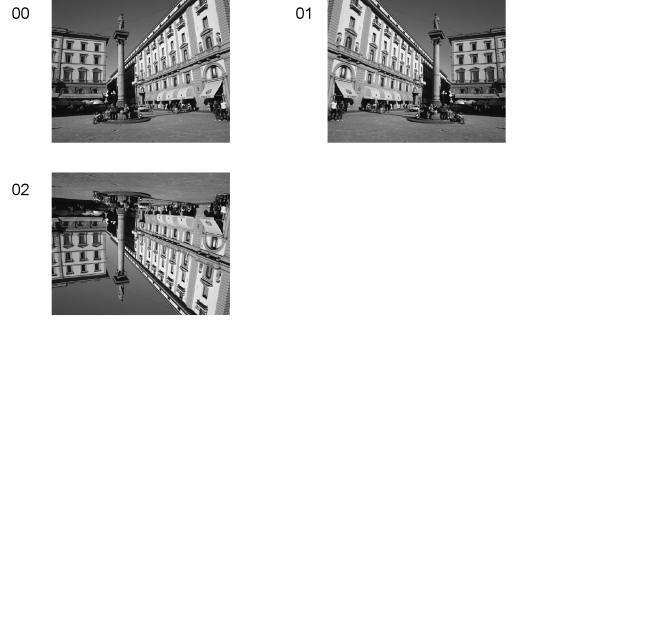
6.2.Option - Mirror
Picture can be reversed left and right or up and down. 00 : Default (Normal picture is displayed)
01 : Picture is reversed left and right.
02 : Picture is reversed up and down.
Hint : If the defective symptom (e.g. Vertical bar or Horizontal bar) is moved by selection of this mirror, the possible cause is in A-board.
6.3.Service tool mode
6.3.1.How to access
1.Select [SRV-TOOL] in Service Mode.
2.Press [OK] button on the remote control.
6.3.2.Display of SOS History
SOS History (Number of LED blinking) indication.
From left side; Last SOS, before Last, three occurrence before, 2nd occurrence after shipment, 1st occurrence after shipment. This indication will be cleared by [Self-check indication and forced to factory shipment setting].
6.3.3.POWER ON Time, On/Off
Note : To display TIME/COUNT menu, highlight position, then press MUTE for 3 sec.
Time : Cumulative power on time, indicated hour : minute by decimal
On/Off : Number of On/Off switching by decimal
Note : This indication will not be cleared by either of the self-checks or any other command.
6.3.4.Exit
1. Disconnect the AC cord from wall outlet or switch off the power with [ Power ] button on the main unit.
13
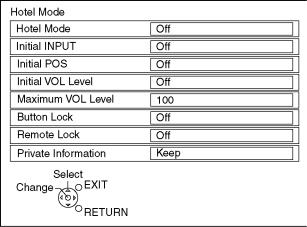
6.4.Hotel mode
1.Purpose
Restrict a function for hotels.
2.Access command to the Hotel mode setup menu In order to display the Hotel mode setup menu:
While pressing [VOLUME (-)] button of the main unit, press [AV] button of the remote control three times within 2 seconds.
Then, the Hotel mode setup menu is displayed.
3.To exit the Hotel mode setup menu Disconnect AC power cord from wall outlet.
4.Explain the Hotel mode setup menu
Item |
Function |
Hotel Mode |
Select hotel mode On/Off |
Initial INPUT |
Select input signal modes. |
|
Set the input, when each time power is switched |
|
on. |
|
Selection : |
|
Off/Analogue/DVB(B)/DVB-C(Y)/DVB-T(Y)/AV1/ |
|
AV2/COMPONENT/HDMI1/HDMI2/HDMI3 |
|
• Off: give priority to a last memory. However, |
|
Euro model is compulsorily set to TV. |
|
• AVnS/AVnC: only Euro model selectable |
Initial POS |
Select programme number. |
|
Selection : |
|
Off/0 to 99 |
|
• Off: give priority to a last memory |
|
|
Initial VOL Level |
Adjust the volume when each time power is |
|
switched on. |
|
Selection/Range : |
|
Off/0 to 100 |
|
• Off: give priority to a last memory |
Maximum VOL |
Adjust maximum volume. |
Level |
Range : |
|
0 to 100 |
Button Lock |
Select local key conditions. |
|
Selection : |
|
Off/SETUP/MENU/ALL |
|
• Off: altogether valid |
|
• SETUP: only F-key is invalid |
|
(Tuning guide (menu) can not be selected.) |
|
• MENU: only F-key is invalid |
|
(only Volume/Mute can be selected.) |
|
• ALL: altogether invalid. |
Remote Lock |
Select remote control key conditions. |
|
Selection : |
|
Off/SETUP/MENU |
|
• Off: altogether valid |
|
• SETUP: only Setup menu is invalid |
|
• MENU: Picture/Sound/Setup menu are invalid |
|
|
Private Information |
Select private information for VIERA Cast is Keep |
|
or Reset if Hotel mode is set to [On] when TV |
|
power on. |
|
Selection : |
|
Keep/Reset |
|
• Keep: private information for VIERA Cast is |
|
keep |
|
• Reset: private information for VIERA Cast is |
|
reset |
|
|
14

6.5.Data Copy by SD Card
6.5.1.Purpose
(a)Board replacement (Copy the data when exchanging A-board):
When exchanging A-board, the data in original A-board can be copied to SD card and then copy to new A-board.
(b)Hotel (Copy the data when installing a number of units in hotel or any facility):
When installing a number of units in hotel or any facility, the data in master TV can be copied to SD card and then copy to other TVs.
6.5.2.Preparation
Make pwd file as startup file for (a) or (b) in a empty SD card.
1.Insert a empty SD card to your PC.
2.Right-click a blank area in a SD card window, point to New, and then click text document. A new file is created by default (New Text Document.txt).
3.Right-click the new text document that you just created and select rename, and then change the name and extension of the file to the following file name for (a) or (b) and press ENTER.
File name:
(a)For Board replacement : boardreplace.pwd
(b)For Hotel : hotel.pwd
Note:
Please make only one file to prevent the operation error.
No any other file should not be in SD card.
15
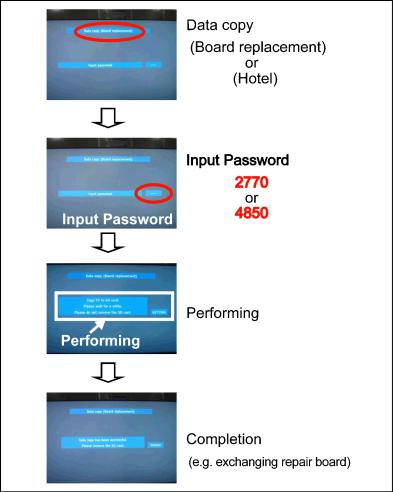
6.5.3.Data copy from TV set to SD Card
1.Turn on the TV set.
2.Insert SD card with a startup file (pwd file) to SD slot.
On-screen Display will be appeared according to the startup file automatically.
3.Input a following password for (a) or (b) by using remote control.
(a)For Board replacement : 2770
(b)For Hotel : 4850
Data will be copied from TV set to SD card.
It takes around 2 to 6 minutes maximum for copying.
4.After the completion of copying to SD card, remove SD card from TV set.
5.Turn off the TV set.
Note:
Following new folder will be created in SD card for data from TV set.
(a)For Board replacement : user_setup
(b)For Hotel : hotel
16
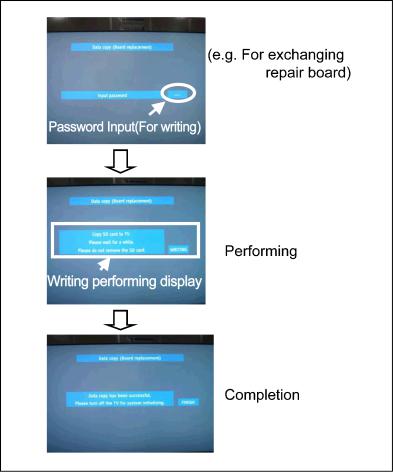
6.5.4.Data copy from SD Card to TV set
1.Turn on the TV set.
2.Insert SD card with Data to SD slot.
On-screen Display will be appeared according to the Data folder automatically.
3.Input a following password for (a) or (b) by using remote control.
(a)For Board replacement : 2771
(b)For Hotel : 4851
Data will be copied from SD card to TV set.
4.After the completion of copying to SD card, remove SD card from TV set.
(a)For Board replacement : Data will be deleted after copying (Limited one copy).
(b)For Hotel : Data will not be deleted and can be used for other TVs.
5.Turn off the TV set.
Note:
1.Depending on the failure of boards, function of Data copy for board replacement does not work.
2.This function can be effective among the same model numbers.
17

7 Troubleshooting Guide
Use the self-check function to test the unit.
1.Checking the IIC bus lines
2.Power LED Blinking timing
7.1.Check of the IIC bus lines
7.1.1.How to access
7.1.1.1.Self-check indication only:
Produce TV reception screen, and while pressing [VOLUME ( - )] button on the main unit, press [OK] button on the remote control for more than 3 seconds.
7.1.1.2.Self-check indication and forced to factory shipment setting:
Produce TV reception screen, and while pressing [VOLUME ( - )] button on the main unit, press [MENU] button on the remote control for more than 3 seconds.
7.1.2.Screen display
7.1.3.Check Point
Confirm the following parts if NG was displayed.
DISPLAY |
Check Ref. No. |
Description |
Check P.C.B. |
TUN |
TU4801 |
TUNER |
A-BOARD |
STBY |
IC8000 |
PEAKS-LDA3(STM) |
A-BOARD |
MEM1 |
IC8902 |
PEAKS EEPROM |
A-BOARD |
MEM2 |
IC8901 |
STM EEPROM |
A-BOARD |
AVSW |
IC3001 |
AUDIO/VIDEO SW |
A-BOARD |
TEMP |
IC2001 |
TEMP SENSOR |
A-BOARD |
LAN |
IC8601 |
ETHERPHY |
A-BOARD |
FE |
IC6700 |
OFDM |
A-BOARD |
ID2 |
|
|
A-BOARD |
LP1 |
IC9300 |
LP1 |
A-BOARD |
IRDRV |
IC5901 |
IR LED DRIVER |
A-BOARD |
7.1.4.Exit
Disconnect the AC cord from wall outlet or switch off the power with [ Power ] button on the main unit.
18
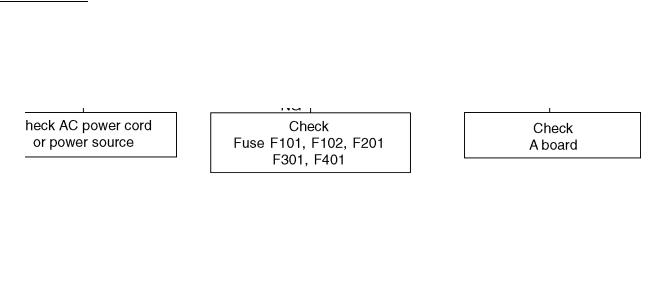
7.2.Power LED Blinking timing chart
1.Subject
Information of LED Flashing timing chart.
2.Contents
When an abnormality has occurred the unit, the protection circuit operates and reset to the stand by mode. At this time, the defective block can be identified by the number of blinks of the Power LED on the front panel of the unit.
Blinking Times |
Contents |
Check point |
1 |
Panel information SOS |
- |
|
PD5 Start SOS |
|
3 |
P+ 3.3V SOS |
A-Board |
4 |
Power SOS |
P-Board |
5 |
P+ 5V SOS |
A-Board |
6 |
Driver SOS1 |
SN-Board |
|
(SN Energy recovery circuit) |
A-SN FPC |
|
(A-SN FPC DET) |
|
|
|
|
7 |
Driver SOS2 |
SN-Board |
|
(SN Connector DET) |
|
|
(SN Scan and Logic IC) |
|
|
|
|
8 |
Driver SOS3 |
SS-Board |
|
(SS FPC DET) |
SS FPC |
|
(SS Energy recovery circuit) |
|
|
|
|
9 |
Discharge Control SOS |
A-Board |
10 |
Sub 5V SOS |
A-Board |
|
Sub 3.3V SOS |
SN-Board |
|
Tuner power SOS |
SS-Board |
|
|
P-Board |
|
|
|
12 |
Sound SOS |
A-Board |
|
|
Speaker |
13 |
Emergency SOS |
A-Board |
14 |
IROM SOS (ROM in Peaks IC) |
A-Board |
|
|
P-Board |
|
|
|
7.3.No Power
First check point
There are following 3 states of No Power indication by power LED.
1.No lit.
2.Green is lit then turns red blinking a few seconds later. (See 7.2.)
3.Only red is lit.
19
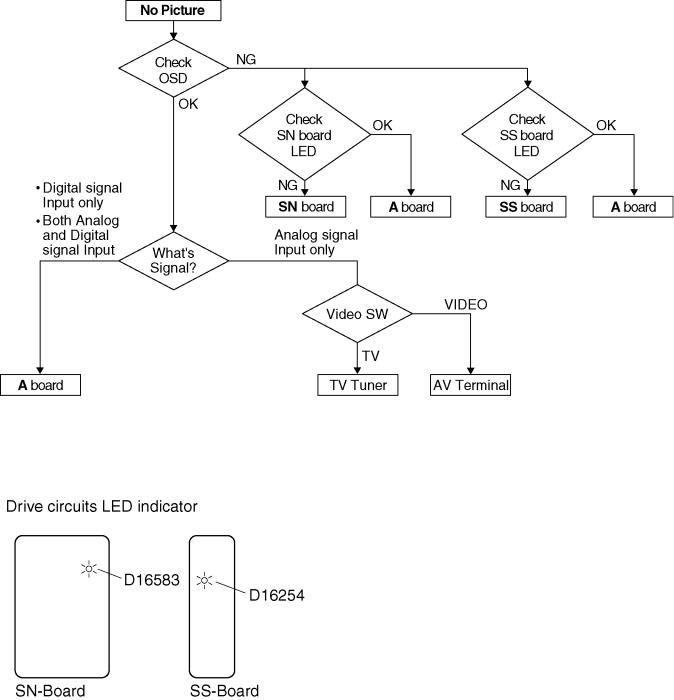
7.4.No Picture
20
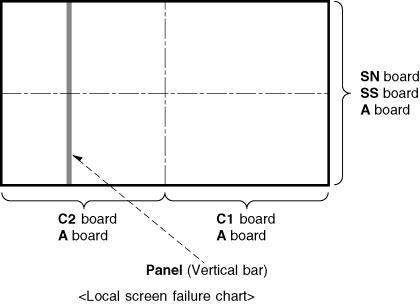
7.5.Local screen failure
Plasma display may have local area failure on the screen. Fig-1 is the possible defect P.C.B. for each local area.
Fig-1
21
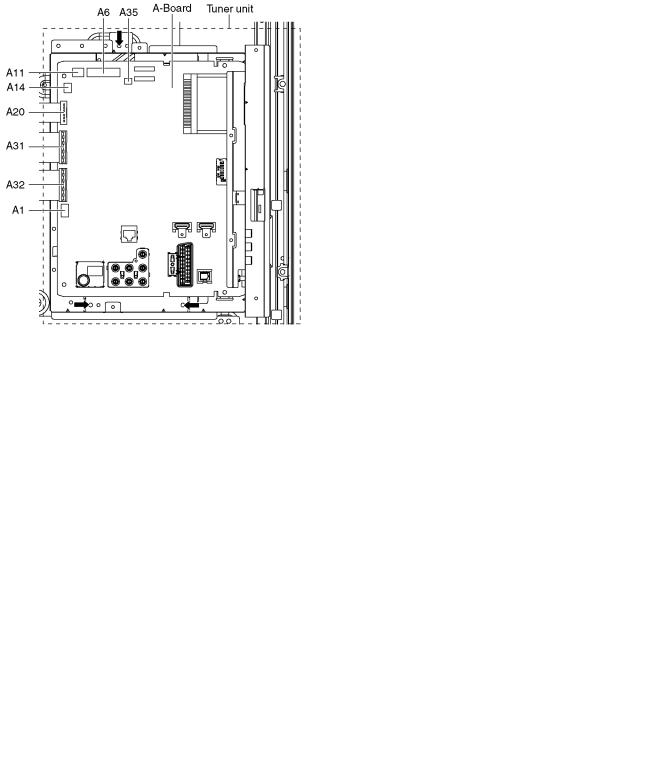
8 Disassembly and Assembly Instructions
8.1.Remove the Rear cover
1. See PCB Layout (Section 3)
8.2.Remove the AC inlet
Caution:
To remove P.C.B. wait 1 minute after power was off for discharge from electrolysis capacitors.
1.Disconnect the connector (P9).
2.Remove the screw (×1  ) and remove the AC inlet.
) and remove the AC inlet.
8.3.Remove the P-Board
8.4.Remove the Side terminal
cover
1.Remove the screws (×2  ).
).
2.Remove the Side terminal cover.
Caution:
To remove P.C.B. wait 1 minute after power was off for discharge from electrolysis capacitors.
1.Disconnect the connectors (P2, P6, P9, P11, P34 and P35).
2. Remove the screws (×7 ) and remove the P-Board. |
8.5. Remove the Tuner unit |
1. Remove the Side terminal cover. (See section 8.4.)
2. Unlock the cable clampers to free the cable.
3. Disconnect the connectors (A1, A6, A11, A14 and A35). 4. Disconnect the flexible cables (A20, A31 and A32).
5. Remove the screws (×3  ) and remove the Tuner unit.
) and remove the Tuner unit.
22
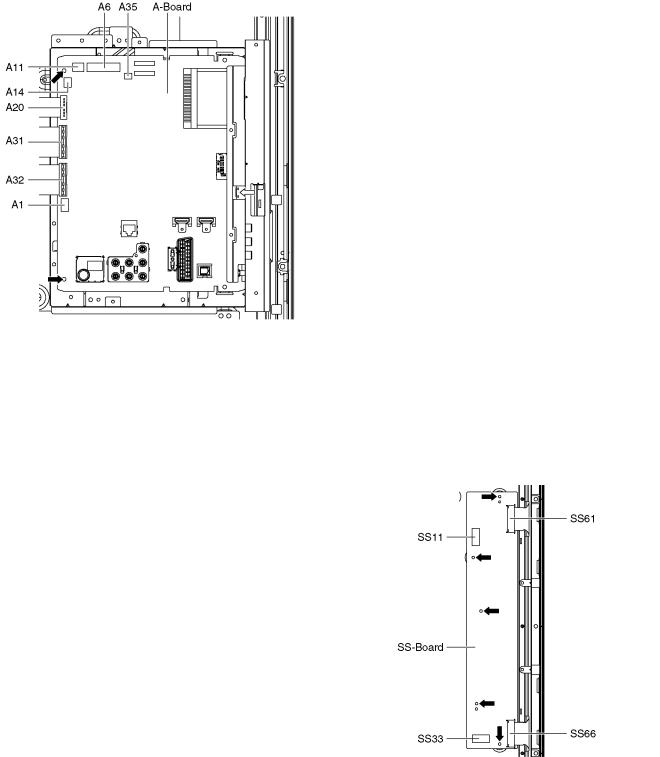
8.6.Remove the A-Board
1.Remove the Tuner unit. (See section 8.5.)
2.Remove the screws (×2  , ×1
, ×1  ) and remove the A- Board.
) and remove the A- Board.
8.7.Remove the Speakers
1.Unlock the cable clampers to free the cable.
2.Disconnect the Speaker terminal.
3.Remove the screws (×2  each) and remove the Speakers (L, R).
each) and remove the Speakers (L, R).
8.8.Remove the SN-Board
1.Disconnect the flexible cables (SN21, SN22, SN23, SN24, SN25, SN26, SN27 and SN28) connected to the SN-Board.
2.Disconnect the connector (SN2).
3.Disconnect the flexible cable (SN20).
4.Remove the screws (×8  ) and remove the SN-Board.
) and remove the SN-Board.
8.9.Remove the SS-Board
1.Remove the Tuner unit. (See section 8.5.)
2.Disconnect the connector (SS11).
3.Disconnect the flexible cable (SS33).
4.Disconnect the flexible cables (SS61 and SS66).
5.Remove the screws (×5  ) and remove the SS-Board.
) and remove the SS-Board.
23
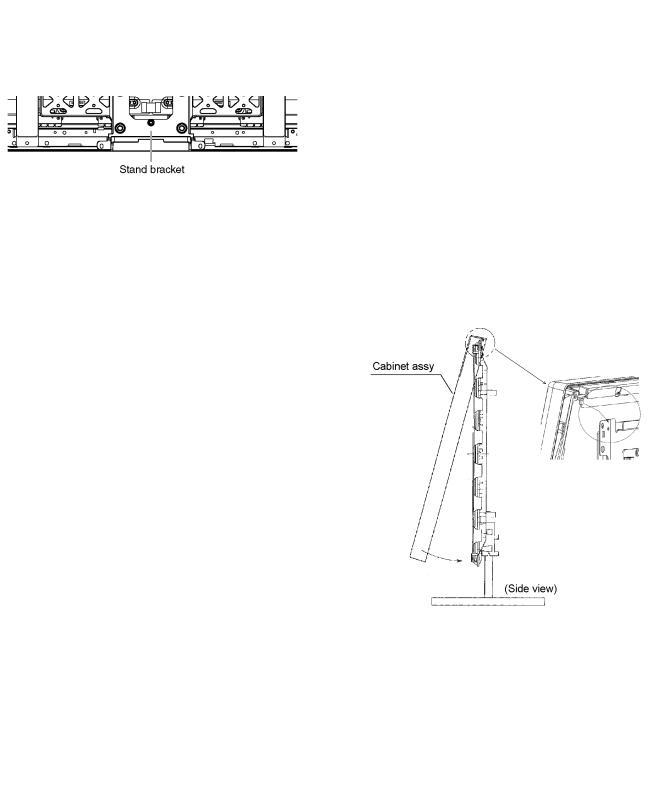
8.10. Remove the Stand bracket and the Hanger metals
1.Remove the Plasma panel section from the servicing stand and lay on a flat surface such as a table (covered by a soft cloth) with the Plasma panel surface facing downward.
2.Unlock the cable clampers to free the cable.
3.Remove the AC inlet. (See section 8.2.)
4.Remove the Stand bracket fastening screws (×5  ) and remove the Stand bracket.
) and remove the Stand bracket.
5.Remove the Hanger metals (L, R) fastening screws (×2  each) and remove the Hanger metals (L, R).
each) and remove the Hanger metals (L, R).
8.11. Remove the Plasma panel section from the Cabinet assy
1.Remove the Plasma panel fastening screws (×4  ) and remove the Cabinet assy.
) and remove the Cabinet assy.
2.For leaving the Cabinet assy from the Plasma panel, pull the bottom of the Cabinet assy forward, lift, and remove.
8.12. Remove the Radiator plate
1.Remove the Stand bracket and the Hanger metals. (See section 8.10.)
2.Remove the screws (×15  ) and remove the Radiator plate.
) and remove the Radiator plate.
24
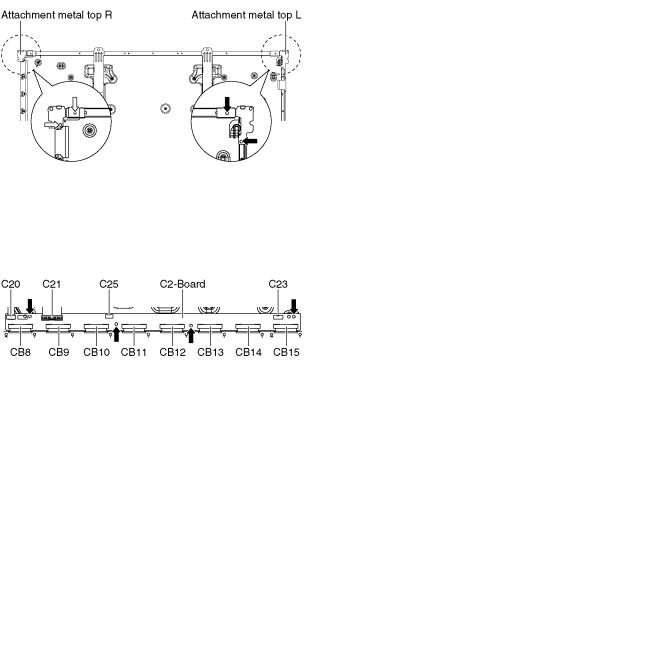
8.13. Remove the C1-Board
1.Remove the Radiator plate. (See section 8.12.)
2.Disconnect the flexible cables (CB1, CB2, CB3, CB4, CB5, CB6 and CB7).
3.Disconnect the flexible cables (C10 and C11).
4.Remove the screws (×4  ) and remove the C1-Board.
) and remove the C1-Board.
8.14. Remove the C2-Board
1.Remove the Radiator plate. (See section 8.12.)
2.Disconnect the flexible cables (CB8, CB9, CB10, CB11, CB12, CB13, CB14 and CB15).
3.Disconnect the flexible cables (C20, C21 and C23).
4.Disconnect the connector (C25).
5.Remove the screws (×4  ) and remove the C2-Board.
) and remove the C2-Board.
8.16. Remove the Attachment metal top
1.Remove the Cabinet assy. (See section 8.11.)
2.Remove the screws (×2  , ×2
, ×2  ) and remove the Attachment metal top (L, R).
) and remove the Attachment metal top (L, R).
8.17. Remove the Glass holders
1.Remove the Cabinet assy. (See section 8.11.)
2.Remove the screws (×5  ).
).
3.Remove the Glass holder top.
4.Remove the screws (×5  ).
).
5.Remove the Glass holder bottom.
6.Remove the screws (×4  ).
).
7.Remove the Glass holder side (L, R).
8.15. Remove the Attachment metal bottom
1.Remove the Radiator plate. (See section 8.12.)
2.Remove the screws (×1  each) and remove the Attachment metal bottom (L, R).
each) and remove the Attachment metal bottom (L, R).
25
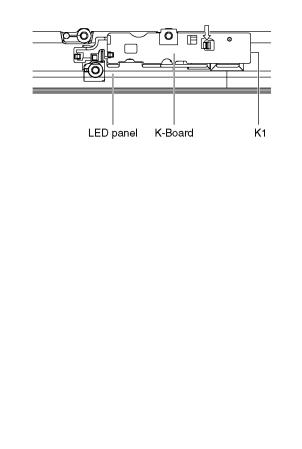
8.18. Remove the K-Board
1.Remove the Glass holder bottom. (See section 8.17.)
2.Remove the claw (×1  ).
).
3.Disconnect the connector (K1) and Remove the K-Board from LED Panel.
8.19. Remove the V-Board
1.Remove the Glass holder bottom. (See section 8.17.)
2.Remove the screw (×1  ).
).
3.Remove the claw (×1  ).
).
4.Disconnect the connector (V14) and remove the V-Board from the 3D emitter panel.
8.20. Replace the Plasma panel
Caution:
A new Plasma panel itself without Hanger metals is fragile.
To avoid the damage to new Plasma panel, carry a new Plasma panel taking hold of the Hanger metals after assembling the Hanger metals and the Stand bracket.
1.Place a carton box packed a new Plasma panel on the flat surface of the work bench.
2.Open a box and without taking a new Plasma panel; Attach the C1-Board and the C2-Board, connect the flexible cables from the Plasma panel to the C1-Board and the C2-Board, and fit the Flexible cable holders.
3.Attach the Hanger metals and the Stand bracket to the new Plasma panel.
4.Place the Plasma panel on the servicing stand taking hold of the Hanger metals.
5.Attach the Cabinet assy and each P.C.Board and so on,
to the new Plasma panel.
*When fitting the Cabinet assy, be careful not to allow any debris, dust or handling residue to remain between the
Front glass and Plasma panel.
26
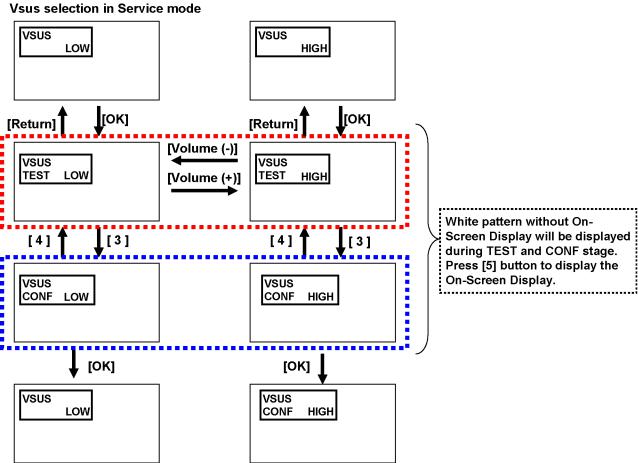
9 Measurements and Adjustments
9.1.Adjustment
9.1.1.Vsus selection
Caution:
When Plasma panel or A-board is replaced, Vsus should be set to LOW or HIGH.
Procedure
1.Go into main item [VSUS] in Service Mode. LOW or HIGH will be displayed.
2.Press [OK] button to go to TEST stage.
White pattern without On-Screen Display will be displayed during TEST and CONF stage. Press [5] button to display the On-Screen Display.
3.Press [VOL (-)] button to set to LOW.
4.In LOW setting
a.If no several dead pixel is visible remarkably in white pattern, press [3] button to go to CONF stage.
b.If the several dead pixels are visible remarkably in white pattern, Set to HIGH by press [VOL (+)] button. Press [3] button to go to CONF stage if the symptom is improved.
5.Press [OK] button in CONF stage to store LOW or HIGH.
6.Exit Service Mode by pressing [Power] button.
27

9.1.2. |
Sub-Contrast adjustment |
|
|
||
|
|
|
|
|
|
|
|
Name of measuring instrument |
|
Connection |
Remarks |
|
RF generator |
|
|
|
|
|
Base Band signal generator |
|
|
|
|
|
HD signal generator |
|
|
|
|
|
|
|
|
|
|
|
|
Steps |
|
|
Remarks |
|
Connect IIC cable (bus controller-cable) after banner OSD appear. |
|
Note: |
||
|
And after SRQ-L, begin an adjustment 2 seconds later. |
|
Sub-contrast adjustment is unadjusted |
||
|
|
|
|
|
for AV/ HD input. |
|
Adjustment of TV (RF system) |
|
But, when needing the adjustment cho- |
||
|
Note: |
|
|
|
sen manually, please refer to [ alterna- |
|
|
|
|
tive method ]. |
|
In adjustment, you must setting to modulation of signal at 80%(B) / 90%(Y).
1. Receive a RF PAL 100% Full White or Split Colour bar shown as below.
2.Goes into service mode.
3.Push a [ 1 ] or [ 2 ] key, and goes into adjustment mode for [ CONTRAST ].
Adjustment
1. The colour key yellow button of remote control is pushed. 2. The OSD character of sub-contrast becomes red.
(Inside under automatic adjustment)
3. The OSD character of sub-contrast returns to black. When [NG] is displayed, adjustment failure.
4. End.
Steps |
Remarks |
Another procedure |
|
Connect IIC cable (bus controller-cable) after banner OSD appear. |
|
And after SRQ-L, begin an adjustment 2 seconds later. |
|
Adjustment of AV system |
|
1. PAL 100% Full White or Split Colour bar receive AV1(or AV2), shown as below. |
|
2.Goes into service mode.
3.Push [ 1 ] or [ 2 ] key, and goes into adjustment mode for [ CONTRAST ].
Adjustment
1.The colour key yellow button of remote control is pushed.
2.The OSD character of sub-contrast becomes red. (Inside under automatic adjustment)
3.The OSD character of sub-contrast returns to black. When [NG] is displayed, adjustment failure.
4.End.
28

|
Steps |
Remarks |
Another procedure |
|
|
Connect IIC cable (bus controller-cable) after banner OSD appear. |
|
|
And after SRQ-L, begin an adjustment 2 seconds later. |
|
|
Adjustment of HD system |
|
|
1. |
At 1080i 100% Full White or Split colour bar receive component signal, as shown below. |
|
2. |
Goes into service mode. |
|
3. |
Push [ 1 ] or [ 2 ] key, and goes into adjustment mode for [ CONTRAST ]. |
|
Adjustment |
|
|
1. |
The colour key yellow button of remote control is pushed. |
|
2. |
The OSD character of sub-contrast becomes red. |
|
|
(Inside under automatic adjustment) |
|
3. |
The OSD character of sub-contrast returns to black. |
|
|
When [NG] is displayed, adjustment failure. |
|
4. |
End. |
|
|
|
|
29

9.1.3.White balance adjustment
The adjusting method is different according to the PEAKS EEPROM version.
[copy adjustment] : Peaks EEPROM ver.1.00-
[Differential and copy adjustment] : Peaks EEPROM ver.1.**-
Name of measuring instrument |
Connection |
Remarks |
W/ B pattern |
Panel surface |
|
Color analyzer |
|
|
(Minolta CA-100 or equivalent) |
|
|
|
|
|
Steps |
|
Remarks |
[copy adjustment] |
|
Picture menu : Dynamic |
Connect IIC cable (bus controller-cable) after banner OSD appear. |
ASPECT : 16:9 |
|
And after SRQ-L, begin an adjustment 2 seconds later. |
|
Condition is same at |
• Make sure the front panel to be used on the final set is fitted. |
|
|
|
alternative method too. |
|
•Make sure a color signal is not being shown before adjustment.
•Put the color analyzer where there is little colour variation.
Note: |
|
Copy Adjustment method in service mode. |
|
When you push [OK] key in each item, |
|
Adjustment data is copied between HD data and SD data. |
|
1. Enter the service mode. |
METHOD=01 |
Please receive the Analog-RF. |
copy adjustments |
Or, please select CVBS/YUV/HDMI. (No inputting is possible.). |
|
(Forbid Analog-RF with no signal.) |
|
2.A number key [1] or [2] are operated and [WB-ADJ] is displayed. Check that the color temp is [COOL].
3.A number key [0] is operated and select [METHOD 01].
4.A number key [5] is operated and [INNER PATTERN] is displayed.
5.Select [G-CUTOFF] item, using the number-key [3] or [4], and set to [80], using the volume-key [+] or [-]. Also, [B-CUTOFF] and [R-CUTOFF] set to [80].
6.Set [G-DRIVE] at [D0].
7.Touch the signal receiver of color analyzer to the INNER PATTERN's center, and adjust B drive and R drive so x, y become the [COLOR TEMP COOL] in the below table1.
8.All RGB drive increase so that the maximum drive value of RGB may become [FF]. ([ALL-DRIVE] set to [FF].)
9.Set color temp to [NORMAL] using [7] key.
10.Fix G-CUTOFF, B-CUTOFF and R-CUTOFF at [80].
11.Set [G-DRIVE] at [D0].
12.Adjust B-DRIVE and R-DRIVE so the INNER PATTERN's x, y become the [COLOR TEMP NORMAL] in the below table1.
13.All RGB drive increase so that the maximum drive value of RGB may become [FF]. ([ALL-DRIVE] set to [FF].)
14.Set color temp to [WARM] using [7] key.
15.Fix G-CUTOFF, B-CUTOFF and R-CUTOFF at [80].
16.Set [G-DRIVE] at [D0].
17.Adjust B-DRIVE and R-DRIVE so the INNER PATTERN's x, y become the [COLOR TEMP WARM] in the below table1.
18.All RGB drive increase so that the maximum drive value of RGB may become [FF]. ([ALL-DRIVE] set to [FF].)
19.Confirm [METHOD=01].
Please refer table2-3 to address.
Asking matter to execute white balance difference adjustment.
Please feed back the DAC value in the adjusted each color temperature in an internal pattern.
30
